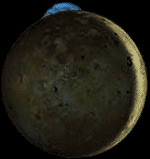


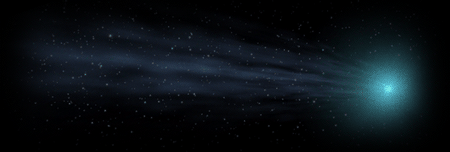

Jupiter, the largest major planet in our Solar Sys- tem, is also the one that spins fastest! Its day is less than 10 Earth-hours
long! (1.6.x) (1.4.1)
Jupiter, the fifth major
planet from the Sun (1.6.x) (1.4.1), is huge! Though a Gas Giant, it is over twice as massive as the seven other major planets combined!
Gravity synchronizes
the orbital periods of Jupiter's 3 inner Galilean moons: Io, Europa and Ganymede! (1.6.x) ![]()
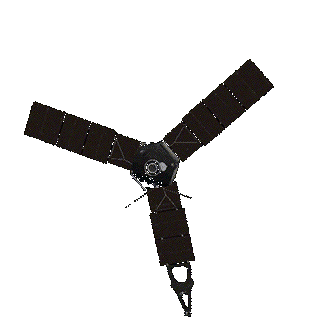
At roughly the orbit of Jupiter, the Sun warms the volatiles in comets enough to vaporize and begin to form separate gas & dust tails. These angle—and often arc— away from the Sun! ![]()
CLOUD VIEWS
As a gas giant, Jupiter lacks any solid or liquid "surface". Instead, what is often called the planet's "visible surface" is actually an unfathomably elaborate cloud system that is differentiated into layers, bands and countless eddies! No spacecraft has yet sent back close-up pictures from within Jupiter's cloud layers, so here are links to artists' depictions of that veiled and mysterious realm.
SkyMarvels™ Art © 2013
NASA Galileo Probe
NASA Galileo Probe
JUPITER ACTIVITIES
MAKE PAPER MODELS: MOONS & SPACECRAFT
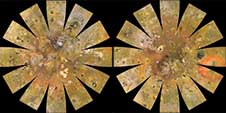
GALILEAN MOONS:
Io: JPG PDF ![]()
Europa: JPG ![]()
Ganymede: JPG ![]()
Callisto: JPG ![]()
SPACECRAFT:
Juno Galileo
A Simpler Jupiter Orbiter
Cassini:
Simple Advanced
Pioneer
And here are collections of 3D paper models from simple to advanced! #1 #2 #3
GALILEAN MOONS
RELATIVE SIZES OF
THE GALILEAN MOONS
Note: the Galilean moons do not rotate at the same speed. Each rotates only once each time it orbits Jupiter. All four are therefore "tidally locked" to their mighty home planet, such that the same side of each Galilean moon always faces Jupiter!
JUPITER
View Jupiter in 3-D! Another ![]() 3-D in Orbit
3-D in Orbit
Current Views and Conditions from Earth Galileans
Current Location in the Constel. Skypath 2025
Current Location in Orbit
Physical Properties:
Equatorial Size: Compare in 3-D
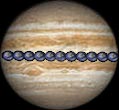
Radius: 71,492 km
Diameter: 142,984 km
Diameter (Earth = 1): 11.209
Rotational Flattening: 0.06487
Mass (Earth = 1): 317.83
Volume (Earth = 1): 1,321.33
Mean Density (Water = 1): 1.31
Mean Density (Earth = 1): 0.240
Gravity at Apparent "Surface" (Earth = 1): 2.530
Axial Tilt: 3.13° ![]()
Where Poles Point ![]()
Rotation Period:
Synodic ("Day" in Earth hours): 9.9259
Sidereal (in Earth hours): 9.9250
Note: Earth Day Lengths
Mean Solar: 24.0000 hours (24h00m00s)
Sidereal: 23.9345 hr (23h56m4.1s)
Note: different latitudes on the Gas Giants
rotate at different speeds.
Albedo (geometric): 0.52
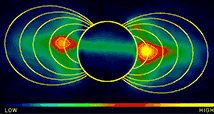
Magnetosphere
Magnetic Field (Earth = 1): 17,900
Magnetic Polarity: opposite that of Earth
Comparison
Juno's Magnetosphere page
NASA Photojournal Image ![]()
Origin
NASA's Overview of Jupiter (in 3D!)
Wikipedia's Jupiter page
NASA Mission Juno site
HubbleSite Jupiter Images
JPL Photojournal
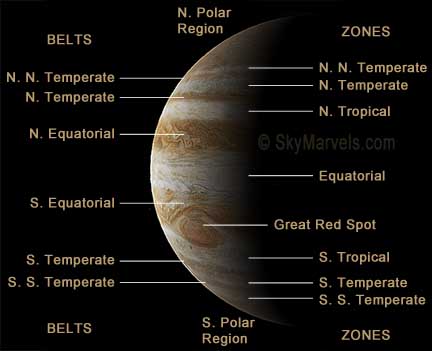 Atmosphere and Clouds:
Atmosphere and Clouds:
NASA Mission Juno: Atmosphere
Wikipedia's Atmosphere of Jupiter page
NASA Vid: Jupiter's Atmospheric Motion
NASA Vid: Atmospheric Motion at Great Red Spot
NASA Vid: Atmospheric Polar Winds
NASA Mission Juno: Maps & Views
Cassini's Best Maps:
Cylindrical ![]() North Polar
North Polar ![]() South Polar
South Polar ![]()
Dramatic Jupiter Southern Storms
Depth of Cloud Bands Juno Cloud Animation
Upper Atmosphere Graphic Auroras
Jupiter Structure:
In 3-D (look for the Galilean Moons too!)
Compared to Other Outer Planets
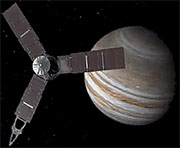
Spacecraft in 3-D:
Juno: #1 ![]() #2 #3 Size
#2 #3 Size
Cassini: #1 ![]() #2 Size
#2 Size
Galileo: #1 ![]() #2 Size
#2 Size
Voyager: #1 ![]() #2 #3 Size
#2 #3 Size
All Four Compared in Size
Pioneer: 10 Size 11 Size
Ring System: Yes
![]()
![]() (very faint)
(very faint)
Planet Classifications:
Outer Planet (along with Saturn, Uranus & Neptune)
Gas Giant (mostly hydrogen and helium)
Superior Planet (has larger orbit than Earth)
Orbit:
(1.6.x)
(1.4.1)
Period: 11.862 Earth years
Distance from Sun:
Mean (Earth = 1 AU): 5.204 AU
Mean: 778,570,000 km
Perihelion: 740,520,000 km (4.950 AU)
Aphelion: 816,620,000 km (5.459 AU)
Velocity:
Mean: 47,052 km/hr
Min: 44,784 km/hr
Max: 49,392 km/hr
Eccentricity: 0.0489
Inclination to Ecliptic: 1.304°
Orbit Shared by: Trojan and Hilda Asteroids ![]()
![]()
Motions of Jupiter and the Trojans
Motions of Jupiter, the Trojans & the Hildas
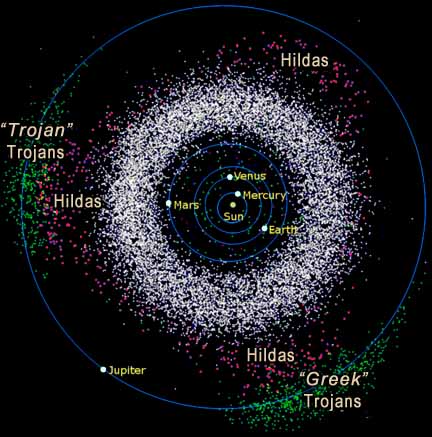
Jupiter Moons: at least 92 (more suspected)
NASA's Overview of Jupiter's Moons
Wikipedia's Moons of Jupiter page
Compare Solar System's Most Active Moons ![]()
Jupiter Moon Tracker
Major Moons: 4 (the "Galilean" Moons)
View Jupiter and Galilean Moons in 3-D
Compare Galileans to Other Moons
Composite View of Galilean Surface Details
Structures of Galilean Moons
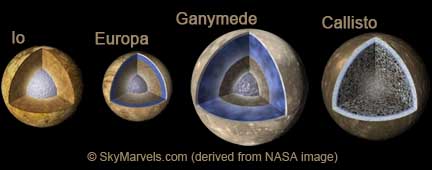
Galileo's Observations of the 4 Major Moons
These can be observed even through a modest tele-
scope or a good pair of binoculars. They are a treat
not to be missed! Current Positions from Earth ![]()
Io:
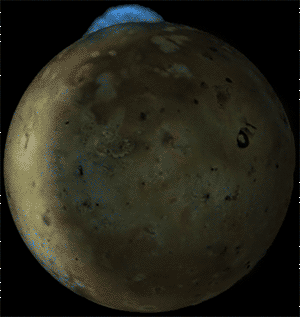 Mean Diameter: 3,643.3 km
Mean Diameter: 3,643.3 km
Rota. & Orb. Period: 1.769 d
Orbital Radius: 421,800 km
View in 3-D ![]() 3-D In Orbit
3-D In Orbit
3-D Globe w/Labels
Structure
![]()
Map 1
w/Labels Map 2
![]()
Wikipedia page Volcanic Io
NASA page JPL Photojournal
Europa:
Mean Diameter: 3,121.6 km
Rotation & Orbital Period: 3.551 d
Orbital Radius: 671,100 km
View in 3-D ![]() 3-D In Orbit
3-D In Orbit
Structure
Detail 1
Detail 2
Detail 3
Europa Tide Video
![]() Map 1
w/Labels
Map 2
Map 1
w/Labels
Map 2
Wikipedia page
NASA page JPL Photojournal
Awesome EUROPA Clipper page Another
Ganymede:
Mean Diameter: 5,268.2 km
Rotation & Orbital Period: 7.155 d
Orbital Radius: 1,070,400 km
View in 3-D ![]() 3-D In Orbit
3-D In Orbit
Structure 1
Struc. 2
Map 1
w/Labels
Map 2
Wikipedia page
NASA page JPL Photojournal
Callisto:
Diameter: 4,820.6 km
Rotation & Orbital Period: 16.689 d
Orbital Radius: 1,882,700 km
View in 3-D ![]() 3-D In Orbit
3-D In Orbit
Structure
Map 1
w/Labels
Map 2
Wikipedia page
NASA page JPL Photojournal
Current Galilean Positions Viewed from Earth ![]()
![]()

Donate safely with: PayPal
and receive one or more
Sky-Gifts. Your support is greatly appreciated!
NOTE: you do not need a PayPal account to donate.
SKY VIEWING
SOLAR SYSTEM
THE SUN
MERCURY
VENUS
EARTH
THE MOON
MARS
JUPITER
SATURN
URANUS
NEPTUNE
SMALLER WORLDS
STELLAR OBJECTS
EXOPLANETS
DEEP-SKY OBJECTS
SCALE OF THE COSMOS
———————
SKY-FUN / SKY-GAMES
NASA's LATEST
JUPITER FUN FACTS
Jupiter rotates on its axis so rapidly, once every 10 hours, that its equator is moving faster than Earth's "escape velocity!"
Jupiter is a massive planet, 2½ times more massive than all of the other planets com- bined!
Every so often, three solar eclipses occur on Jupiter at the same time!
Jupiter's "Great Red Spot" appears to be shrinking! A hundred years ago it was twice as long as it is now!
Jupiter's moon Europa
![]()
is believed to have twice as much water as Earth!
Some astronomers consider Jupiter a "star that failed!" It does not have enough mass for stellar nuclear reactions to have begun in its core.
When it approached Jupiter in 2016, the Juno spacecraft was travelling at 165,000 mph and was the fastest object ever made by humankind!
JUPITER INTERACTIVES
QUICK ACCESS LIST
Note: some links are echoed elsewhere on this page and may include descriptive text.
An excellent interactive NASA site: Mission Juno
Links to interactive features that show Jupiter's orbit in
3-D can be found on our Solar System page
Excellent tool for advanced Galilean moon enthusiasts: Gravity Simulator.
Jupiter Viewer: find the tilt
of Jupiter, its rings, and the location of its major moons, for any time and date.
Jupiter Moon Tracker: gener- ate and download charts of locations of Jupiter's major moons and rings over time.
SKYMARVELS™
POSTERS FEATURING JUPITER
SKYMARVELS™
VIDEOS FEATURING JUPITER
Jupiter Mutual Eclipse: 2010 March 31
GALILEAN MOONS
FUN FACTS
The Galilean moons were discovered in 1610!
The eclipses of Io led astron- omers to the first determina- tion of the speed of light!
It is possible for two or three Galilean moons to cast their shadows on Jupiter at the same time! (1.6.x) But never all four at once!
Sometimes one Galilean can cast its shadow on another! Such an occurance is called a mutual eclipse.
IO FUN FACTS
Io was the first moon to be discovered orbiting a planet other than Earth!
Io has more volcanic activity than any other body in the Solar System!
EUROPA FUN FACTS
Europa's icy crust gives it the highest reflectivity of any known moon!
A sub-surface ocean extends fully around Europa! We will soon search for life there!
GANYMEDE FUN FACTS
Ganymede is the largest moon in the Solar System!
Ganymede is the only moon to have a magnetosphere!
CALLISTO FUN FACTS
Like Europa, Callisto may have a sub-surface ocean!
Callisto is more heavily cratered than any other object in the Solar System!
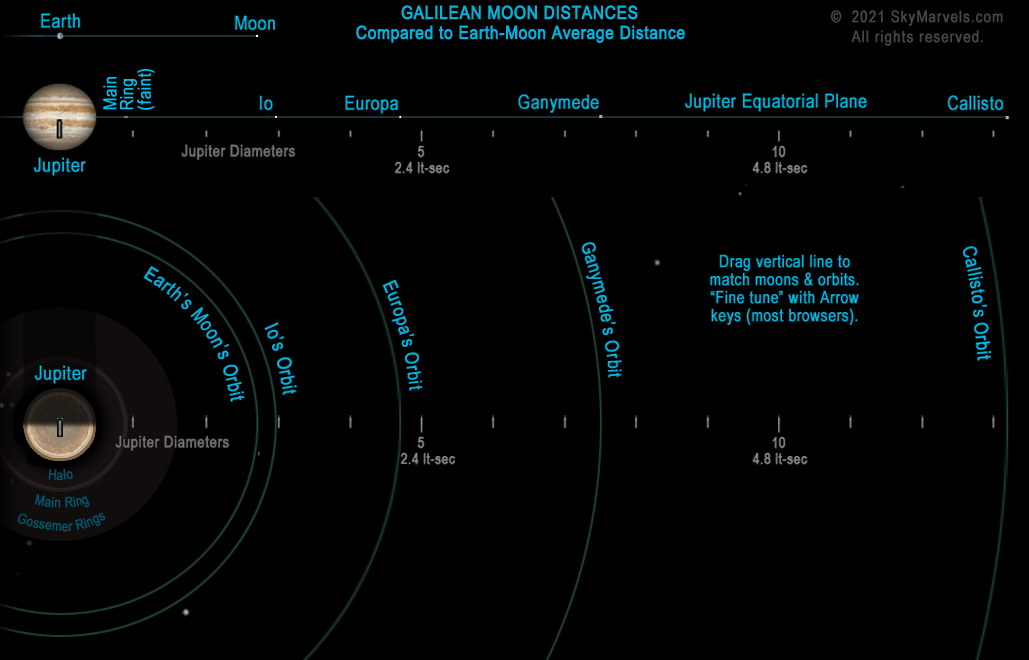
Light requires about
6 seconds to travel from Jupiter to Callisto!
ELEMENTS OF THE GALILEAN ORBITS
| Period (Earth Days) |
Orbital Inclin- ation |
Radius (103 km) |
Eccen- tricity |
|
|---|---|---|---|---|
| Io | 1.769 | 0.04° | 421.8 | 0.004 |
| Eur | 3.551 | 0.47° | 671.1 | 0.009 |
| Gan | 7.155 | 0.18° | 1,070.4 | 0.001 |
| Cal | 16.69 | 0.19° | 1,882.7 | 0.007 |
The three inner Galilean
moons are locked in a continuous gravitational
"tug-of-war" that actually synchronizes their orbits!
Note: if you let the animation at right run long enough, the alignments that occur due to the Galilean-resonances can be seen rotating or "precess- ing" slowly clockwise (retro- grade), which they do about every 1.3 years!
Relative to the heavens,
the Galilean-resonance alignments rotate "back- ward" (retrograde) about once every 1.3 years!
Likewise, the long shadow of Jupiter, which produces each moon's lunar eclipses, can be observed rotating even more slowly "counter"-clockwise (prograde), this actually the result of the mighty planet's progression in its 11.862-year orbit around the Sun! At the time-scale of the animation, the Galilean resonances pre- cess 360° roughly every half- hour, while the shadow of Jupiter rotates fully about once every four hours!
A GALILEAN MOON ERROR IN "2001"
As noted and shown at right, all 3 inner Galilean moons can never align on the same side of Jupiter. However, the sci-fi classic movie 2001: A SPACE ODYSSEY does have a much- talked-about sequence which shows this occurring. It has been reported that the author, Arthur C. Clarke, was aware of this error, but that he and the director, Stanley Kubrick, de- cided to exercise a bit of "ar- tistic license" and include the view for its dramatic effect.
ECLIPSES INVOLVING
THE GALILEAN MOONS
Solar eclipses and lunar eclipses occur frequently at Jupiter. In the former case,
the planet presents a sizeable target on which the shadows of its moons may fall. In the latter case, Jupiter casts a huge shadow through which its moons often must pass!
The comparison of apparent sizes just to the left confirms that all 4 Galilean moons are capable of "totally hiding" the Sun in Jupiter's skies. Below it, the Galilean Resonances animation demonstrates that the 3 inner Galilean moons proceed through Jupiter's umbra essentially each time they orbit the planet! This is because Jupiter's equatorial plane tilts only 3.13° to its or-bital plane, and the Galileans orbit nearly in Jupiter's equa- torial plane! Incidentally, . . .
Of all the systems of
major moons orbiting
the major planets, the
Galilean system is the
most closely aligned
to the Ecliptic plane!
This all results in an impres- sive number of eclipses that involve the Galilean moons. "Eclipse Finder" in Celestia gives these Galilean eclipse figures for 2021 and 2022:
| 2021 Solar |
2021 Lunar |
2022 Solar |
2022 Lunar |
|
|---|---|---|---|---|
| Io | 206 | 206 | 206 | 204 |
| Eur. | 102 | 103 | 103 | 102 |
| Gan. | 51 | 51 | 51 | 51 |
| Cal. | 22 | 22 | 18 | 19 |
As expected, moons farther from Jupiter produce fewer solar eclipses and likewise experience fewer lunar ones.
At Jupiter's equinoxes (every 6 years ) its Gali-
lean moons may eclipse 'one another" producing "mutual eclipses"!
![]()
JUPITER'S EQUINOXES
As each planet moves through the Solar System, twice during each orbit its equatorial plane aligns with the Sun. From a planet's own perspective, this is when the Sun moves across its celestial equator in its sky, and the planet's Northern and Southern Hemispheres are illu-minated equally.
Jupiter's equinoxes occur, on average, just less than every six years. As the Galileans all orbit Jupiter nearly in its equa- torial plane, the circumstances that are most conducive to producing their multiple and mutual eclipses always occur close to the Jovian equinoxes.
Jupiter's last equinox occured on 2021 May 2. Its next five will occur on ...
2026 Dec 17 2033 Mar 13
2038 Oct 27 2045 Jan 23
2050 Sep 8.
The four Galilean Moons orbit
Jupiter very close to its equatorial
plane and in nearly circular orbits!
Current Galilean Positions: NASA/JPL Orrery
Opens showing Jupiter. Scroll out with mouse-
wheel to see Galilean moons in orbit.
Gravity Simulator is an escellent tool for advanced
Galilean enthusiasts. Has other scenarios too.

GALILEAN RESONANCES
Throughout the heavens, gravity and motion often work in concert to produce fascinating phenomena. Owing to the constant gravitational "tug-of-war" governing their motions, Io orbits Jupiter four times in the same period that Europa orbits twice and Ganymede orbits once! As it turns out, such orbital resonances have been found to be quite common in the Solar System, and they often result in intriguing secondary consequences.
For example, when Io and Europa—the two inner Gali- lean moons—"line up" with Jupiter on the same side
of the planet, as they do roughly every 3,6 days, Gany- mede is always 90° from their alignment! In addidtion, when all three inner Galilean moons do "line up"—with each other and with Jupiter, which they also do roughly every 3.6 days—then Ganymede and one other moon are on one side of the planet, while the third moon must be on the opposite side! These conditions can be ob- served in the animation above, and they mean that . . .
. . . all 3 inner Galilean moons can never
"line up" on the same side of Jupiter!
JUPITER'S SWARM OF MOONS
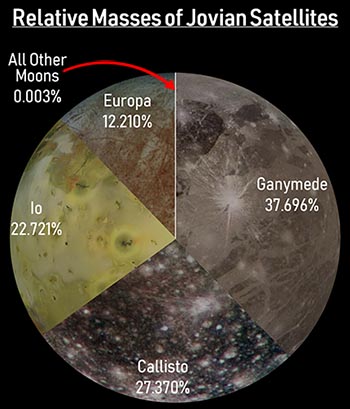
Outer Moons of Jupiter
![]()
Partial Information Source: NASA Fact Sheets
ADJECTIVES MEANING
"pertaining to Jupiter"
Jupiterian (used primarily in science-fiction)
Jovian (from Greek god, Jove)
Jupiter Mutual Eclipse: 2010 March 31
JUPITER: Largest of the Planets
video credit: NASA
JUPITER'S INTERIOR
video credit: NASA/JPL-Caltech
Home Intro News Gallery Sky-Gifts Bonuses Tips
Learning Ctr Help Links Credits Legal Contact Us
© 2007-
by Gary M. Winter. All rights reserved.
Interested in political cartoons and humor?
Check out The HIPPLOMATS™.
SkyMarvels, Sky Marvels, SkyMarvels.com, celestia4all, celestiaforall, CELESTIA, astronomy, space, simulations, animations, downloadable astronomy posters, stars, planets, Inner Planets, Outer Planets, Inferior Planets, Superior Planets, moons, asteroids, comets, Oort Cloud, galaxy, galaxies, Milky Way, Andromeda, globular clusters, binaries, quasars, black holes, supermassive black holes, telescope, telescopes, planetarium, software, freestuff, satellites, add-ons, addons, scripts, eclipses, Solar Eclipses, Lunar Eclipses, Solar Eclipse Finder, Lunar Eclipse Finder, mutual eclipses, transits, occultations, Solar System, CELES-TOOLS, celeSTARrium, CELX, CELX programming, Freebies, Bonuses, multiple views, atronomical unit, light year, parsec, meteors, meteor showers, Perseids, Geminids, Leonids, barycenter, time, Time Zones, tides, alignments, conjunctions, oppositions, seasons, apogees, perigees, aphelion, perihelion, Earth, Luna, Mercury, Venus, Mars, Jupiter, Galilean Moons, Io, Europa, Ganymede, Callisto, Saturn, Titan, rings, Uranus, Neptune, Triton, E-MSpectrum, electromagnetic spectrum, astronaut, equinoxes, solstices, precession, rotation, spin, inclination, tilt, Ecliptic, orbits, ellipse, parabola, hyperbola